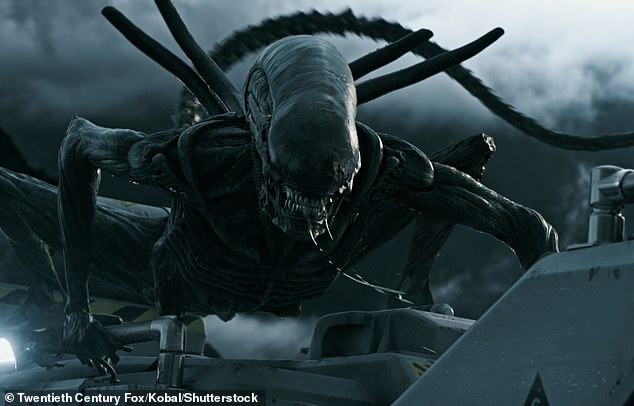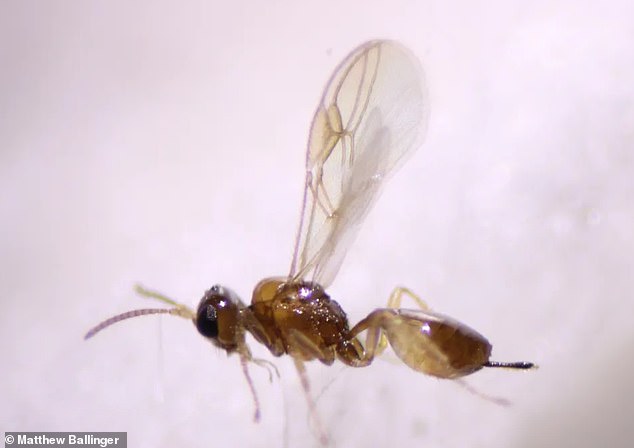Parasitic ‘horror’ wasp that grows inside bodies of living flies found in US for first time
Scientists have accidentally discovered a previously unknown species of parasitic wasp that grows inside the bodies of living flies and then bursts out of their stomachs, just like a xenomorph from the ‘Alien’ films.
A team of researchers stumbled upon this new species of wasp, now named S. perlmani, while collecting fruit flies from their backyards in Mississippi.
This is the first wasp to infect adult fruit flies. Other parasitic wasp species only target fruit flies during their early larval and pupal stages.
S. perlmani uses their needle-like ovipositor to insert into the abdomen of a fruit fly and lay an egg. The egg then hatches as a wasp larva, which grows inside the fly for 18 days before exploding out of its host, leaving it to die.
S. perlmani is a recently discovered species of parasitic wasp that grows inside a fruit fly and then bursts out of its abdomen, fatally wounding its host.
“It will effectively come out of the side of the fly,” study lead researcher and Mississippi State University biologist Logan Moore said. Living science.
‘And to make matters even more gruesome, the fly normally remains alive for hours afterwards.’
Moore and his team published their findings Wednesday in the journal Nature.
The researchers eventually conducted a DNA analysis that showed the wasps were found throughout the eastern U.S. In addition, Moore and his colleagues were able to find them in Mississippi, Alabama and North Carolina.
But when they first encountered this species in March 2023, they thought it was a fluke.
“We didn’t think it was real back then,” Moore said. “If you dissect thousands of flies, you’re going to see things that are strange and weird, and you’re never going to see them again.”
When the team made their discovery, they were actually hunting for a different parasite: they were monitoring fruit flies for parasitic worms called nematodes.
But their attention was drawn to the larvae of spiny-tailed wasps in the abdomens of some flies.

S. Perlmani’s life strategy resembles that of the xenomorphs from the ‘Alien’ films
The researchers collected these parasite-infected fruit flies and brought them to the lab to observe how the wasp larvae developed and to study their DNA.
Once the larvae were fully grown, the wasps left their host, explored their new environment for a few hours, and then buried themselves in a substrate provided by the researchers.
The wasps then entered a cocoon for 23 days to complete their growth before emerging as adult wasps.
The researchers paired the adult wasps with different species of fruit flies from the genus Drosophila to see which types of flies they would infect.
When the team first discovered the wasp larvae in their backyards, they had infected a species of fruit fly, Drosophila affinis. But they wanted to see if these wasps could also infect other species of fruit flies.
After the lab-raised adult wasps emerged from their cocoon stage, the researchers paired them with several species of fruit flies from the Drosophila genus. They found that the wasps could also infect Drosophila acutilabella.

Adult S. perlmani wasps can parasitize several species of fruit flies
The researchers also found the wasps’ DNA signatures in a public database of Drosophila melanogaster genomic data, suggesting the wasp may also parasitize this species.
Scientists have used fruit flies as a research subject for centuries, largely because they are easy to find, breed, and study.
This begs the question: why has no parasite been discovered to target such a well-studied insect until now?
“I think maybe the only thing that explains why it’s gone undiscovered for so long is that no one wants it,” Moore said.
‘There is not yet a single parasitic wasp known that can infect not only the adult stages of Drosophila, but also flies in general.’
That’s because the early stages of insects, such as larvae and pupae, are much more vulnerable to parasitic attacks. They don’t have an exoskeleton to protect them and they don’t have wings to help them escape, Moore explained.
Scientists still have much to learn about this new wasp species.
“This is all around us, infecting one of the best-studied animals on the planet,” Moore said. “It just makes you wonder what else is on our doorstep.”
